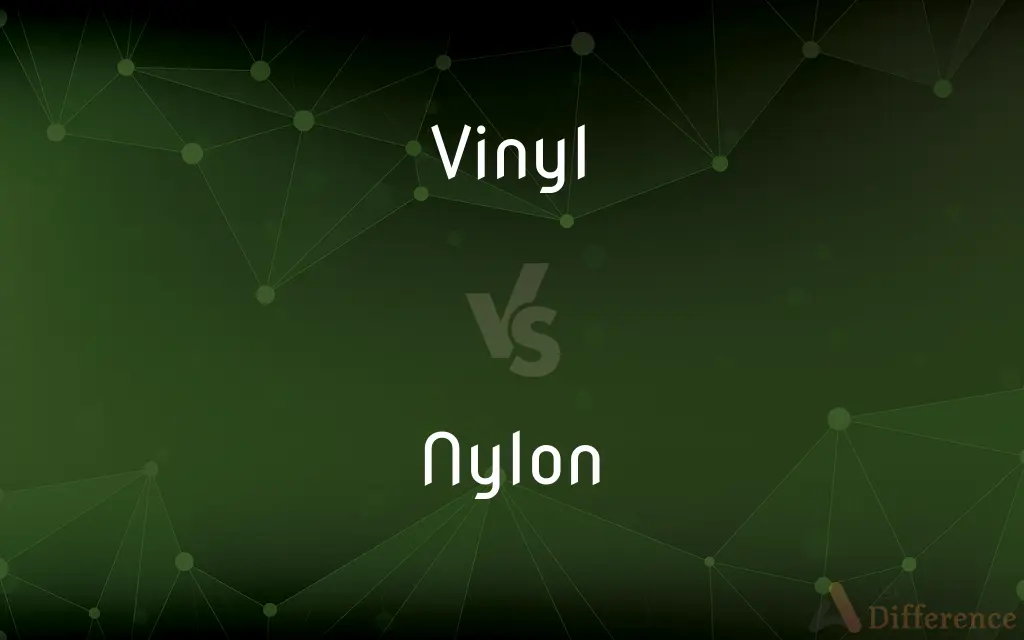Vinyl vs. Nylon — What's the Difference?
By Urooj Arif & Fiza Rafique — Updated on March 19, 2024
Vinyl is versatile synthetic plastic polymer used in wide range of applications, known for its durability and resistance to moisture. Nylon is synthetic polymer used as fiber in textile, known for its strength, elasticity, and resistance to wear and tear.

Difference Between Vinyl and Nylon
Table of Contents
ADVERTISEMENT
Key Differences
Vinyl, or polyvinyl chloride (PVC), is a plastic polymer that is flexible, durable, and water-resistant, making it popular for products like flooring, records, and outdoor furniture. Its versatility allows it to be manufactured in both rigid and flexible forms. Nylon, a type of polyamide, is renowned for its strength and elasticity, which makes it ideal for use in clothing, ropes, and automotive parts. Unlike vinyl, which is often used in solid form, nylon is commonly spun into fibers or filaments.
The production process of vinyl involves the polymerization of vinyl chloride, resulting in a material that can be both hard and soft, depending on the added plasticizers. Nylon's production, on the other hand, typically involves condensation polymerization, leading to a material that is inherently strong and flexible, without the need for additives.
In terms of environmental impact, vinyl has faced criticism due to the release of harmful chemicals during its production and disposal. Nylon, while also a synthetic polymer, tends to have a slightly better environmental profile, especially in the context of recyclability and energy consumption in production, though it still poses challenges in terms of non-biodegradability.
Vinyl is often chosen for its cost-effectiveness and resistance to environmental factors, making it suitable for outdoor and heavy-duty applications. Nylon, with its wear resistance and strength, is preferred in applications where durability and flexibility are crucial, such as in textiles and automotive components.
Both materials have their distinct advantages and applications, with vinyl being favored for its waterproof properties and versatility in products requiring rigidity or flexibility, and nylon being preferred for its strength, elasticity, and durability in wear-prone applications.
ADVERTISEMENT
Comparison Chart
Composition
Synthetic plastic polymer
Synthetic polyamide polymer
Key Properties
Durability, moisture resistance
Strength, elasticity, wear resistance
Common Uses
Flooring, records, outdoor furniture
Textiles, ropes, automotive parts
Production Process
Polymerization of vinyl chloride
Condensation polymerization of polyamides
Environmental Impact
Concerns over chemical release
Challenges in recyclability, less energy-intensive production
Cost
Generally cost-effective
Can be more expensive due to production costs
Flexibility
Can be adjusted (rigid or flexible)
Naturally strong and flexible
Application Focus
Versatile uses, both indoor and outdoor
Primarily in fibrous applications
Compare with Definitions
Vinyl
A durable synthetic plastic used in diverse applications.
Vinyl flooring is popular for its water resistance.
Nylon
A strong synthetic fiber used in textiles.
Nylon stockings are known for their durability and stretch.
Vinyl
Can be made rigid or flexible.
Flexible vinyl is used in garden hoses.
Nylon
Notable for elasticity and wear resistance.
Nylon is often used in outdoor gear for its durability.
Vinyl
Used in both consumer goods and industrial applications.
Vinyl records have made a comeback among music enthusiasts.
Nylon
Often chosen for high-stress applications.
Nylon is used in automotive parts for its resistance to wear.
Vinyl
Known for moisture resistance.
Vinyl tarps are used to protect outdoor equipment.
Nylon
Can be more environmentally friendly than some alternatives.
Recycled nylon is used in eco-conscious fashion.
Vinyl
Faces environmental scrutiny.
The production of vinyl windows raises environmental concerns.
Nylon
Used in both apparel and industrial products.
Nylon ropes are valued for their strength and flexibility.
Vinyl
Synthetic resin or plastic consisting of polyvinyl chloride or a related polymer, used for wallpapers and other covering materials and for gramophone records
The vinyl is cut to size with a craft knife
Vinyl floor tiles
Nylon
Nylon is a generic designation for a family of synthetic polymers composed of polyamides (repeating units linked by amide links). Nylon is a silk-like thermoplastic, generally made from petroleum, that can be melt-processed into fibers, films, or shapes.
Vinyl
Of or denoting the unsaturated hydrocarbon radical —CH=CH₂, derived from ethylene by removal of a hydrogen atom
A vinyl group
Nylon
Any of a family of high-strength, resilient synthetic polymers, the molecules of which contain the recurring amide group CONH.
Vinyl
The univalent hydrocarbon group CH2=CH, derived from ethylene.
Nylon
Cloth or yarn made from one of these synthetic materials.
Vinyl
Any of various compounds containing the vinyl group, typically highly reactive, easily polymerized, and used as basic materials for plastics.
Nylon
Nylons Stockings made of one of these synthetic materials.
Vinyl
Any of various typically tough, flexible, shiny plastics, often used for coverings and clothing.
Nylon
Originally, the DuPont company trade name for polyamide, a copolymer whose molecules consist of alternating diamine and dicarboxylic acid monomers bonded together; now generically used for this type of polymer.
Vinyl
Phonograph records considered as a group
A secondhand store that buys and sells vinyl.
Nylon
(in the plural) A stocking originally fabricated from nylon; also used generically for any long, sheer stocking worn on a woman's legs.
I tore a hole in my nylons while walking home through the woods.
Vinyl
The univalent radical CH2=CH−, derived from ethylene.
Nylon
(perjoratively, by comparison to silk) A Queen's Counsel, King's Counsel or Senior Counsel who was appointed as a courtesy, rather than on merit.
Vinyl
(countable) Any of various compounds and substances containing the vinyl radical, especially various tough, flexible, shiny plastics.
Nylon
Any of several thermoplastic polyamide plastics, comprising a family of high-strength resilient synthetic materials, used mostly in fibers.
Vinyl
Phonograph records as a medium.
Many DJs prefer vinyl to CDs.
Nylon
A synthetic fabric consisting of fibers of nylon[wn1].
Vinyl
A phonograph record.
Nylon
Stockings made of a thin form of nylon{2}, especially full-length stockings either sheer of of varying shades.
Vinyl
(chemistry) Containing the vinyl radical.
Nylon
A thermoplastic polyamide; a family of high-strength resilient synthetic materials
Vinyl
Made of polyvinyl chloride.
Nylon
A synthetic fabric
Vinyl
(music) Pertaining to a phonograph record.
Vinyl
The hypothetical radical C2H3, regarded as the characteristic residue of ethylene and that related series of unsaturated hydrocarbons with which the allyl compounds are homologous.
Vinyl
A univalent chemical radical derived from ethylene
Vinyl
Shiny and tough and flexible plastic; used especially for floor coverings
Common Curiosities
How do the production costs of vinyl and nylon compare?
Vinyl tends to be more cost-effective due to its simpler production process, whereas nylon's production can be more energy-intensive, making it potentially more expensive.
Can vinyl be recycled?
Vinyl can be recycled, but the process is complex due to the presence of additives like plasticizers and stabilizers.
Why is nylon favored in the textile industry?
Nylon's strength, elasticity, and resistance to wear and tear make it ideal for a wide range of textiles, from clothing to home furnishings.
What is vinyl most commonly used for?
Vinyl is widely used in construction materials, like flooring and pipes, as well as in consumer goods like records and outdoor furniture.
Is nylon biodegradable?
Nylon is not biodegradable and can take decades to break down in the environment, posing a challenge for waste management.
How do vinyl and nylon affect sustainability efforts?
Both materials pose challenges for sustainability due to issues with recyclability and environmental impact, though efforts are being made to improve their production and disposal processes.
How is nylon used in the automotive industry?
In the automotive industry, nylon is used in parts like engine covers, airbags, and seat belts due to its durability and resistance to heat and chemicals.
What makes vinyl a popular choice for outdoor applications?
Vinyl's resistance to water, UV light, and general wear makes it a preferred choice for outdoor furniture, siding, and fencing.
What are the environmental concerns associated with vinyl?
The production and disposal of vinyl can release harmful chemicals, including dioxins, which raise significant environmental and health concerns.
Can the flexibility of nylon and vinyl be compared?
While both materials can be flexible, nylon's flexibility is inherent to its polymer structure, whereas vinyl's flexibility can be adjusted with plasticizers.
Share Your Discovery

Previous Comparison
Bill vs. Receipt
Next Comparison
Vagrant vs. HoboAuthor Spotlight
Written by
Urooj ArifUrooj is a skilled content writer at Ask Difference, known for her exceptional ability to simplify complex topics into engaging and informative content. With a passion for research and a flair for clear, concise writing, she consistently delivers articles that resonate with our diverse audience.
Co-written by
Fiza RafiqueFiza Rafique is a skilled content writer at AskDifference.com, where she meticulously refines and enhances written pieces. Drawing from her vast editorial expertise, Fiza ensures clarity, accuracy, and precision in every article. Passionate about language, she continually seeks to elevate the quality of content for readers worldwide.
















































